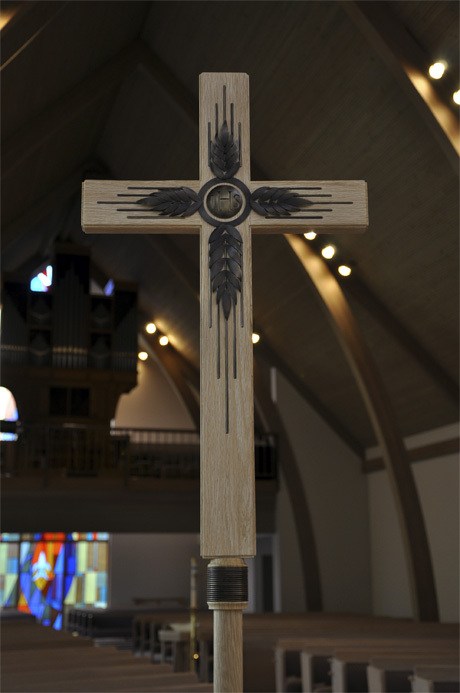A new processional cross in the sanctuary of Holy Trinity Lutheran Church has replaced the cross that was stolen a year ago. The near-replica, created by the same artist, was officially dedicated on Sunday, Sept. 20. The cross is carried down the aisle at the beginning of each worship service and placed in a wooden stand next to the pulpit.
It was the youth of the church’s junior-high confirmation class who first expressed the desire for a replacement after the theft occurred.
While learning about Protestant Reformation leader Martin Luther at a confirmation retreat, the seventh- through 9th-graders drafted a list of changes that they wanted to happen at HTLC and posted the list on a church door, as Luther did with the famed 95 theses. One item on the list was getting a new processional cross.
“The youth said that would be a really good thing,” said Kirsten Olshausen, Holy Trinity Lutheran secretary. “It was an expression of hope: we’re not going to be discouraged from having this theft.”
Local woodworker Laura Yeats was again commissioned for the project, along with metal worker Caroline Davis. The original cross, dedicated in 2003, had been the product of five artists — a gift from former congregation member Herman Kelsch before his death, in memory of his wife, Gerry. Its whereabouts remain unknown, and no suspects have been identified.
The new cross has the same design: four heads of burnished brass wheat surround a center medallion inscribed with “IHS,” the Greek monogram for the name of Jesus Christ. Inspiration for the wheat design came from communion and the biblical Bread of Life concept — that eternal life is found in Jesus. The hymn, “As the Grains of Wheat,” was also a source of inspiration.
Now, the cross is displayed only during Sunday services.
“It was very clear, people said — let’s make sure we lock this up during the week. [The theft] does make you feel more vulnerable, and yet I don’t think there’s any question that we’d want to still keep our worship space open,” said Olshausen, noting that the sanctuary is open throughout the week for people who want to pray there. “You don’t want to get too attached to objects, but they are part of what we use in our worship service.”




